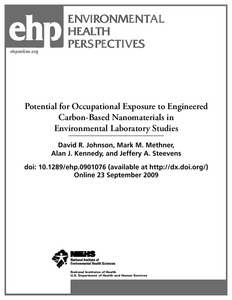Potential for occupational exposure to engineered carbon-based nanomaterials in environmental laboratory studies
"Background: The potential exists for laboratory personnel to be exposed to engineered carbonaceous nanomaterials (CNMs) in studies aimed at producing conditions similar to those found in natural surface waters (e.g., presence of natural organic matter (NOM)). Objective: The goal of this preli...
| Main Authors: | , , , |
|---|---|
| Institution: | ETUI-European Trade Union Institute |
| Format: | TEXT |
| Language: | English |
| Published: |
Environmental Health Perspectives
2009
|
| Subjects: | |
| Online Access: | https://www.labourline.org/KENTIKA-19174247124919924299-Potential-for-occupational-exp.htm |
| Summary: | "Background: The potential exists for laboratory personnel to be exposed to engineered carbonaceous nanomaterials (CNMs) in studies aimed at producing conditions similar to those found in natural surface waters (e.g., presence of natural organic matter (NOM)).
Objective: The goal of this preliminary investigation was to assess the release of CNMs into the laboratory atmosphere during handling and sonication into environmentally-relevant matrices.
Methods: Fullerenes (C60), underivatized multi-walled carbon nanotubes (raw MWCNT), hydroxylated MWCNT (MWCNT-OH), and carbon black (CB) were measured in air as these nanomaterials were weighed, transferred to beakers filled with reconstituted freshwater, and sonicated in de-ionized water and reconstituted freshwater with and without NOM. Airborne nanomaterials emitted during processing were quantified using two handheld particle counters that measure total particle number concentration per volume of air within the nanometer range (10-1000 nm) and six specific size ranges (300-10,000 nm). Particle size and morphology were determined by transmission electron microscopy of air sample filters.
Discussion: After correcting for background particle number concentrations, it was evident that increases in airborne particle number concentrations occurred for each nanomaterial except CB during weighing, with airborne particle number concentrations inversely related to particle size. Sonicating nanomaterial-spiked water resulted in increased airborne nanomaterials, most notably for MWCNT-OH in water with NOM and for CB.
Conclusion: Engineered nanomaterials can become airborne when mixed in solution by sonication, especially when nanomaterials are functionalized or in water containing natural organic matter. This finding indicates that laboratory workers may be at increased risk of exposure to engineered nanomaterials." |
|---|---|
| Physical Description: | 29 p. Digital |

